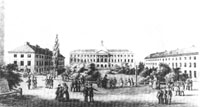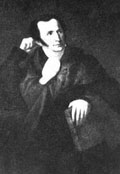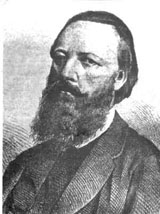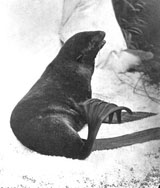 The origin of the Museum and Institute dates back to the 19th century. After purchasing the zoological collection of Baron Sylwiusz Minckwitz from Gronowice in Silesia in 1818 , the Commission of Religion and Public Education of the Polish Kingdom created the Zoological Cabinet at the Chair of Zoology of the Royal University of Warsaw in 1819.
The origin of the Museum and Institute dates back to the 19th century. After purchasing the zoological collection of Baron Sylwiusz Minckwitz from Gronowice in Silesia in 1818 , the Commission of Religion and Public Education of the Polish Kingdom created the Zoological Cabinet at the Chair of Zoology of the Royal University of Warsaw in 1819.
Its first curator being Doctor of Liberal Arts and Philosophy, Feliks Pawel Jarocki, soon nominated an "adopted professor" and the head of the Chair of Zoology. Minckwitz's collection included about 20,000 specimens, among which the bird collection was especially valuable. A part of the collection has been preserved till now in the Museum's collection.
 After becoming head of the Zoological Cabinet and the Chair of Zoology, Jarocki started accumulating a library indispensable for collection, curating and lecturing. Due to his efforts, many valuable volumes were obtained, which made it possible for him and his successors to curate the materials preserved in the Cabinet. When Jarocki retired in 1862, and transferred the Zoological Cabinet to the Main School, the then "inheritor" of the Royal University of Warsaw, the zoological collection included 65,690 specimens, and the library consisted of 291 volumes.In 1862 Wladyslaw Taczanowski became the new head of the Cabinet. At the same time, Benedykt Dybowski was nominated head of the Chair of Zoology and Comparative Anatomy of the Main School. In new atmosphere, in a short time Taczanowski managed to gather around the Zoological Cabinet a large group of co-workers - both naturalists from various institutions, and amateurs interested in nature: Ludwik Hildt - coleopterologist, Jan Sztolcman - ornithologist, Antoni Waga - entomologist, Jan Sznabl and Henryk Dziedzicki - both dipterologists, and Kazimierz Stronczynski - entomologist, the author of "Rozrywki entomologiczne dla młodzieży" (1835) [Entomological diversions for teenagers].Taczanowski succeeded in gaining patrons for the Zoological Cabinet: these were Konstanty Branicki and Aleksander Branicki and later Wladysław Branicki, who in 1862-1874 organised three expeditions to north Africa (Algeria, Egypt, Nubia). Materials accumulated during the expeditions were transferred to the Zoological Cabinet.
After becoming head of the Zoological Cabinet and the Chair of Zoology, Jarocki started accumulating a library indispensable for collection, curating and lecturing. Due to his efforts, many valuable volumes were obtained, which made it possible for him and his successors to curate the materials preserved in the Cabinet. When Jarocki retired in 1862, and transferred the Zoological Cabinet to the Main School, the then "inheritor" of the Royal University of Warsaw, the zoological collection included 65,690 specimens, and the library consisted of 291 volumes.In 1862 Wladyslaw Taczanowski became the new head of the Cabinet. At the same time, Benedykt Dybowski was nominated head of the Chair of Zoology and Comparative Anatomy of the Main School. In new atmosphere, in a short time Taczanowski managed to gather around the Zoological Cabinet a large group of co-workers - both naturalists from various institutions, and amateurs interested in nature: Ludwik Hildt - coleopterologist, Jan Sztolcman - ornithologist, Antoni Waga - entomologist, Jan Sznabl and Henryk Dziedzicki - both dipterologists, and Kazimierz Stronczynski - entomologist, the author of "Rozrywki entomologiczne dla młodzieży" (1835) [Entomological diversions for teenagers].Taczanowski succeeded in gaining patrons for the Zoological Cabinet: these were Konstanty Branicki and Aleksander Branicki and later Wladysław Branicki, who in 1862-1874 organised three expeditions to north Africa (Algeria, Egypt, Nubia). Materials accumulated during the expeditions were transferred to the Zoological Cabinet.
{mosimage}The Branicki brothers also covered the costs of the expedition of Jan Sztolcman in Peru and Ecuador (1875-1881, 1882-1884) and financially supported Konstanty Jelski's studies in Guiana and Peru (1866-1875). Very valuable collections accumulated by these investigators were initially transferred to the Zoological Cabinet.
After the fall of the January Uprising (1863-1864), many Polish naturalists became political exiles in Siberia. while in exile Benedykt Dybowski, Wiktor Godlewski and Michal Janowski, were able to study the fauna of Lake Baikal and other regions of eastern Siberia. They sent their materials to the Zoological Cabinet. Taczanowski also co-operated with Polish naturalists working in various parts of the world: Ludwik Mlokosiewicz from the Caucasus, Jan Kubary - explorer of Oceania and Konstanty Jelski from Guiana and Peru, who enriched the Zoological Cabinet with valuable specimens.In 1862-1890 the Zoological Cabinet was an important European scientific institution housing a zoological collection and which were very rich for contemporary possibilities of the country. The staff and co-workers of the Cabinet conducted wide-ranging studies on the systematics and distribution of native and foreign fauna. Many animal groups, both from the areas of Poland and from eastern Siberia, South America, Central Asia, Transcaucasia and other areas, were studied. Hundred of new animal genera and species were described. Many publications had a pioneer character (studies on the fauna of the Lake Baikal carried out by Dybowski, or investigations on the spiders and birds of South America by Taczanowski).
They have gained a permanent place in scientific literature and form a part of the world's scientific achievements.In 1869 the Main School was closed and replaced by the Emperor's Warsaw University, with Russian as an official language. Growing russification pressure increasingly limited activities of the Polish staff of the Zoological Cabinet. At the same time the Branicki brothers, fearing that the collections might be sent to Russia, stopped transferring materials they accumulated to the Cabinet and established, in 1887, a private Zoological Museum. Its first head was Jan Sztolcman. The Branicki brothers kept sponsoring scientific expeditions: Jan Kalinowski's in 1883-1885 to the Ussuri Territory and the lake Chanka, in 1885-1888 to Korea and Japan, in 1889-1902 to Peru. They also accumulated a very rich library containing mostly ornithological works.
 A new stage in the development of the Museum began in 1919. On the strength of the decree of the Ministry of Religion and Public Education of 24th September 1919 the National Museum of Natural History - Zoological Department was established . Most of the collections of the Zoological Cabinet and collections of the Branicki's Zoological Museum became a new collection of our Museum. The status of the Museum was finally established in 1928, by the decree of the President of the Polish Republic, the new name being State Zoological Museum.
A new stage in the development of the Museum began in 1919. On the strength of the decree of the Ministry of Religion and Public Education of 24th September 1919 the National Museum of Natural History - Zoological Department was established . Most of the collections of the Zoological Cabinet and collections of the Branicki's Zoological Museum became a new collection of our Museum. The status of the Museum was finally established in 1928, by the decree of the President of the Polish Republic, the new name being State Zoological Museum.
1921 and 1939 the Museum organised numerous scientific expeditions: in 1921 to Brazil by Tadeusz Chrostowski and Tadeusz Jaczewski, in 1929 to Mexico by Tadeusz Jaczewski and Tadeusz Wolski, to Egypt in 1930-1931 by Waclaw Roszkowski, and three cruises of "Dar Pomorza" in the Atlantic Ocean. During these expeditions members of the Museum staff collected valuable zoological material of both marine and terrestrial fauna.
A very significant event in the development of the Museum was establishing its own publishing office. In 1921 the first issue of Annales Zoologici Musei Polonici Historiae Naturalis appeared, in 1930 - Fragmenta Faunistica, and in 1933 - Acta Ornithologica. The journals published papers by the Museum staff, by Polish zoologists from other institutions and by foreign authors. All these journals are still published at present and the first one is indexed/abstracted by the Institute for Scientific Information in Philadelphia, USA.
 During the 2nd World War, the staff who reported to work and volunteers arranged and catalogued zoological collection. After the Warsaw Uprising the Museum staff who were not deported to Germany, tried to secure the collection. From November 1944 till January 1945 they managed to secure all the zoological collection that had remained. The most valuable collections were saved: ornithological, malacological, arachnological and collections of insects from Madagascar.
During the 2nd World War, the staff who reported to work and volunteers arranged and catalogued zoological collection. After the Warsaw Uprising the Museum staff who were not deported to Germany, tried to secure the collection. From November 1944 till January 1945 they managed to secure all the zoological collection that had remained. The most valuable collections were saved: ornithological, malacological, arachnological and collections of insects from Madagascar.
After the liberation of Warsaw the staff immediately started securing the building and the collections. Based on the authorization issued by the Ministry of Education, Ministry of Administration and the Chief Commanding Staff of the Polish Army, the Museum employees undertook a search for and securing of collection of the former German institutions and those abandoned by private amateur-collectors. From December 1945 till November 1946, the former head of the Museum - Tadeusz Jaczewski, as a reclaim liaison officer at the Polish Revindication Commission, searched for and secured Polish zoological collections plundered by the Germans during the war. As a result most of deported collections returned to the Museum. The Museum collection increased considerably also due to numerous private donations.
A next stage in the development of the Museum started in 1952. The Zoological Institute was founded with the establishment of the Polish Academy of Sciences. Establishing the Zoological Institute within the Polish Academy of Sciences (PAS) brought a financial improvement, which made it possible to employ more staff - scientific and technical and purchase of new research equipment. Thanks to international agreements of the PAS with academies of other countries the Institute employees could make scientific visits and have access to collections of many institutions. Abroad field research was carried out mainly in European (Bulgaria, Greece, Yugoslavia, Romania, Hungary) and south-east Asian countries (Indonesia, Vietnam, China, Korea, Mongolia). The trips enriched the Institute collection with hundred of thousands of specimens of several thousand species not previously represented in the collection, hundreds of new species and their types. The wide research possibilities brought about considerable increase the range of research, both systematic and faunistic. The number of monographs of the fauna of large geographic areas increased considerably.
In the 70s, in order to increase the engagement of science in economic problems, a system of objective financing of science was introduced. A basic plan research was then prepared at the Zoological Institute. The main attention was paid to the native fauna, both environmentally and regionally. In both these directions the Institute played a role of organiser of scientific teams and co-ordinator of research in the entire country. Studies on the fauna of typical habitats in Poland, carried out with quantitative methods, had a zoocenological character. They resulted in a picture of the main types of land habitats in the Polish Lowlands, considering the effect of human economic activities. During the studies, the fauna of city parks, riverine forests, wet meadows, sparse oak forests and pine forests was studied. In these studies, co-ordinated by the Institute, numerous zoologists took part, from many scientific institution of Poland.
Halfway through 1992 the Institute changed its name to the Museum and Institute Zoology (M&IŻ). The new name better reflected the present functions and referred to the tradition. Exhibition activities were resumed, the first exhibition being "Animals of South America in the Collection of the Museum and Institute of Zoology PAS", opened on February 1994. At the same time intense scientific research were conducted at the M&IZ, concerning on the following topics: systematics of invertebrates, mainly insects; faunistics with species reference to regions and typical habitats of Poland; and sociobiology and mechanisms of animal evolution.
On March 1st 1995 a ceremonial session of the Scientific Council was held at the Museum and Institute of Zoology, devoted to the 175 anniversary of the Zoological Cabinet and the 75 anniversary of the Museum of Zoology in Warsaw.









